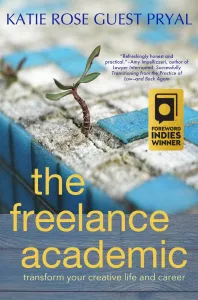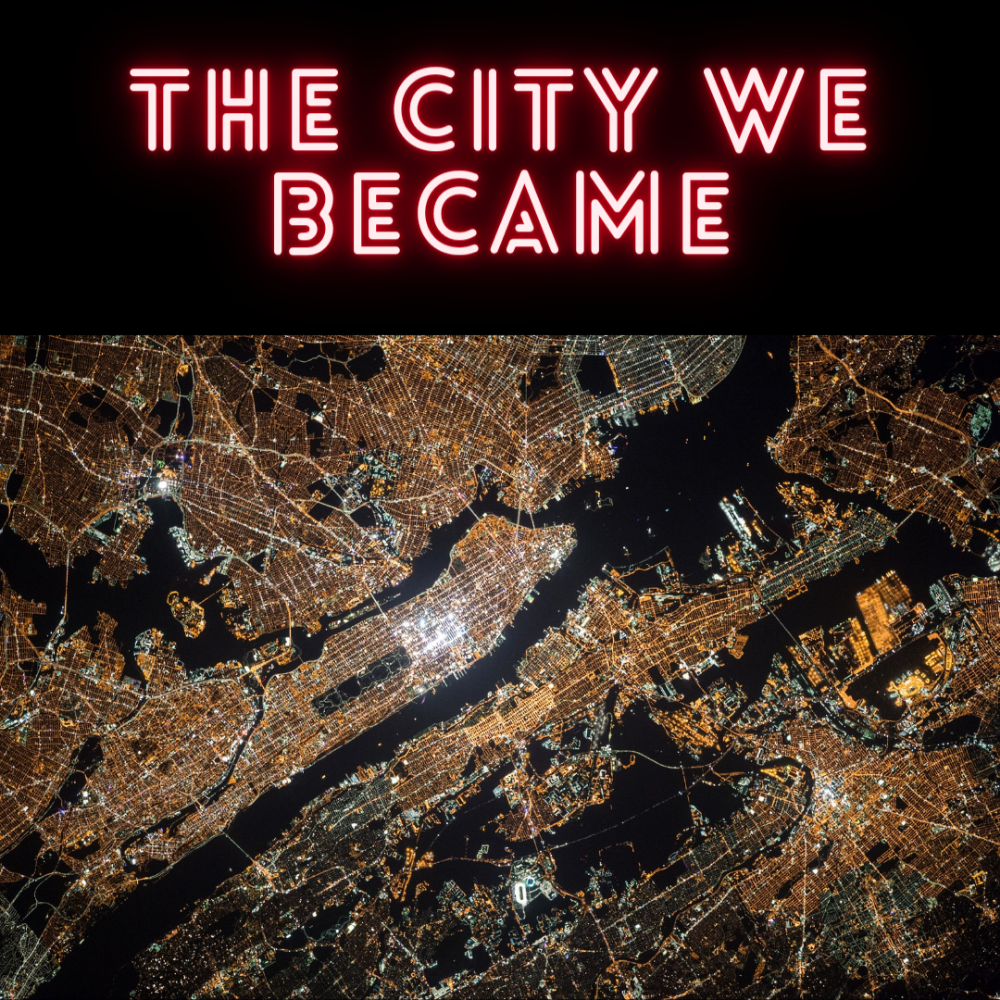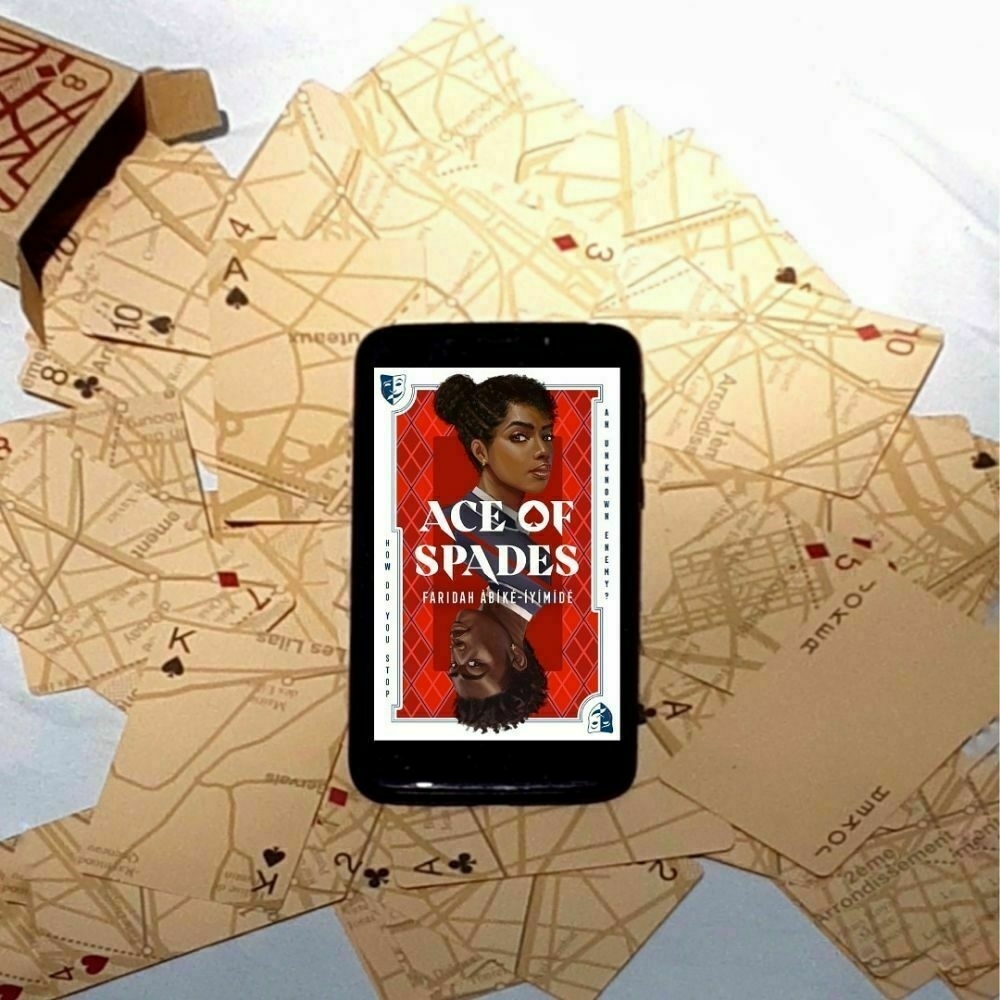
I’ve read Katie Rose Guest Pryal’s The Freelance Academic twice now. It’s a great book. I’ve taken notes on it and highlighted all over the place but I feel like I haven’t internalized the notes. So I thought I’d blog some notes, highlights, and marginalia. This blog post is no substitute for reading the book, so if this information seems useful, be sure to check it out!
The Freelance Academic Manifesto
Originally posted on Dr. Pryal’s blog.
- Get paid for your work.
- Live in a place you love with people you love.
- When you find yourself being lured back to your department for a temporary gig, remember: They’re never going to let you in the club.
- Stop applying to academic jobs.
- Remember that you are not alone.
Things to Do
- Read books “about how higher education has changed and how how people have dealt with these changing conditions.” p. 13
- “…read everything you can about how to start making money for the hard work you do.” p. 14
- “Take a course on how to pitch ideas to writer’s markets that pay, either through online courses or by hiring a successful freelancer friend to teach you.” p.18
- “…hire an academic career coach, who specializes in helping people transition out of the academy.” p. 18
- Finish outstanding academic commitments such as papers.
- Write your goodbye letter.
- Figure out what you’re good at by making a list of your superpowers.
- Make a list of things you’re an expert in.
- Add topics you might want to write about.
- “…figure out who would be interested in reading what you have to say in these areas.” p. 138
- Some ideas: trade magazines, in-house blogging or copywriting.
- Make a list of at least 10 story ideas so you can choose 1 to pitch.
- After you’ve pitched and written one article, pitch a series.
- Learn about running a business.
- “Find out what the going rates are in the private sector for what you do. Think about the rates that you should be charging, and start charging those rates. And remember, when you set your rates, you have to add 30%.” p. 123
- Pay yourself a steady paycheck.
- Standardize the services you offer.
- Technology
- email
- data storage (hard drive/cloud)
- laptop
- email signature
- Library access
- Find out if you can use your university library with something like a community membership.
- Online presence
- Update social media profiles
- Get a Facebook business page.
- Get testimonials from clients and put them on your website and social media profiles.
- Business cards
- Business structure
- “Hire an academic career coach.” p. 18
- Professionalize yourself as a non-academic.
- “Get your research out there, just as it is.” (p. 42)
- Make your research publicly accessible on your own website and on “open-access repositories that are indexed on Google.” p. 39
- “Create an internet presence.” (p. 43)
- Learn “about website design, coding, and hosting.” p. 24
- Change your website from a CV to an online portfolio.
- “Buy the URL (web address) that is your name.” (p. 43)
- Create one page for your education and experience.
- Create another page for your publications.
- Link your publications to your repository page.
- Add a blog.
- Share your blog posts on social media.
- Blog about important things.
- Establish your areas of expertise on your blog.
- When blogging, “Be honest and always link it to the larger trends and structural issues.” p. 32 (quoting Lee Skallerup Bessette)
- “Put a bullet point on your website about your experience with grant writing or professional writing.” p. 117
- Make connections on Twitter and Instagram. Network and share your scholarship.
- “Share your ideas – widely.” p. 44
- “…put yourself in a position to engage publicly with your research.” p. 39
- Figure out which publishing venues “are interested in which genres.” p. 44
- “Take a course on how to pitch ideas to writer’s markets that pay, either through online courses or by hiring a successful freelancer friend to teach you.” p. 18
- “Read the magazines you want to write for. Learn who the editors are by reading their work.” p. 45
- “Start pitching articles in your area of expertise that are ‘pegged’ (tied) to current events.” p. 45
- “Reach out to your freelance academic colleagues and ask for help” coming up with creative solutions to problems. Also ask your coach. p. 51
- “Build a community, whether online or off, of others who are trying to do work similar to yours.” p. 80
- “…always have a clean, up-to-date résumé ready as a safety net.” p. 174
Things to Read
- To Write or Not to Write, Kelly J. Baker
- Should Academics Write for Free?, Sarah Kendzior
- Hanging Up on a Calling, Rebecca Schuman
- Love and Other Secondhand Emotions, Jacqui Shine
- On Graduate School and “Love,” William Pannapacker
- The No Baby Penalty, Elizabeth Keenan
- The Responsibility of Adjunct Intellectuals, Corey Robin
- What’s the Point of Academic Publishing?, Sarah Kendzior
- Thesis Hatement, Rebecca Schuman
- Sexism Ed, Kelly J. Baker
- Why Everybody Loses When Someone Leaves Academe, Erin Bartram
- Instead of Gaslighting Adjuncts, We Could Help Them, Annemarie Pérez
- Don’t Fear the Résumé, Rachel Leventhal-Weiner
- The Black Boy Looks at the White Boy Norman Mailer, James Baldwin
- Student Arrested after Crawling into a Duct to Steal an Exam, Christopher Mele
- Getting to Yes: Negotiating Agreement Without Giving In, Roger Fisher and William Ury
- What is BATNA? How to Find Your Best Alternative to a Negotiated Agreement, Guhan Subramanian
- Academic Waste, Kelly J. Baker
- How the University Works, Marc Bousquet
- Build a Career Worth Having, Nathaniel Koloc
- Why Freelancers Need a Nonpayment Law, Sara Horowitz
- How to Craft a Pitch, Kelly J. Baker
- Recommended Reading and Resources starting on p. 175
People, organizations, and resources to look up
Highlights
Highlight (pink) - Page 15
As Sarah Kendzior wrote in 2013 for Chronicle Vitae, “Should academics ever write for free? Maybe. Should academics write for free for a publisher that can afford to pay them? Never.”
Highlight (yellow) - Page 16
Mostly, you should never be shy about talking about money, and a publication shouldn’t be shy about it either.
Highlight (yellow) - Page 16
Living away from the people we love is the opposite of living as a human being.
Highlight (yellow) - Page 17
You no longer have only one path to success— the path through traditional academic streams. Now you have a universe of paths.
Highlight (yellow) - Page 18
use the time and money you will save by not applying for jobs to start freelancing.
Highlight (pink) - 1. What Does It Mean to Be a Freelance Academic? > Page 25
As Rebecca Schuman has accurately put it (many times), academia suffers from a “cult mentality” that is hard to see until you step away from it.
Highlight (yellow) - 1. What Does It Mean to Be a Freelance Academic? > Page 27
the biggest change required to become a freelance academic is to recognize that, in the words of a dear friend from grad school, They’re never going to let you in the club.
Highlight (yellow) - 3. On Writing > Page 43
Whichever repository you choose, know that you have the right to share your work with the world, and you don’t have to rely on institutional access to do it.
Highlight (yellow) - 3. On Writing > Page 46
when you orient your scholarship toward its obvious yet overlooked purpose— furthering human knowledge— its value does not need to be determined by others, because the value lies in the work itself.
Highlight (yellow) - 4. Epiphany > Page 49
Our tracks are, by necessity, only limited by our own creativity. They literally (there’s that word again) are what we make them.
Highlight (yellow) - 4. Epiphany > Page 49
When we’re confronted with a job offer or a gig that isn’t quite right for us, instead of turning it down outright (like I did when I received that job offer), we have an opportunity to make the job right— through negotiation or other tactics.
Highlight (yellow) - 10. The University Is Just Another Client > Page 75
Contingency has turned higher education into just another part of the gig economy.
Highlight (yellow) - 10. The University Is Just Another Client > Page 77
giving administrators your work for free does not inspire them to reward you.
Highlight (yellow) - 10. The University Is Just Another Client > Page 78
As a freelancer, your institution is just one of your many clients. That means you need to spend your extra time and energy on projects that earn you both money and respect outside of one particular institution.
Highlight (yellow) - 10. The University Is Just Another Client > Page 78
Freelancers don’t make a living hoping one client will keep hiring them over and over. They form relationships; they find other clients.
Highlight (yellow) - 10. The University Is Just Another Client > Page 79
you can only be loyal to a company that is loyal to you.
Highlight (pink) - 11. The Ugly Side of Academia > Page 81
I came across some words by James Baldwin recently: “The price one pays for pursuing any profession, or calling, is an intimate knowledge of its ugly side.” Now, Baldwin was talking about race, and masculinity, and his relationship with Norman Mailer. The entire essay (published in the May 1961 issue of Esquire magazine) is breathtaking, and you should read it.
Highlight (blue) - 15. Leaving a Legacy Off the Tenure Track > Page 103
Sit down and figure out what you want to leave behind in this world. Then figure out what kind of freedom— agency— you need in order to gain the skills— mastery— to be able to produce that kind of legacy.
Highlight (pink) - 16. Why Attend Conferences as a Freelance Academic? > Page 107
bring your freelancer skills back into the academy via a scholarly conference.
Highlight (blue) - 18. Launch Your Career Like James Bond > Page 117
when you create your freelance writer website, take into account all of the things that you are.
Highlight (blue) - 18. Launch Your Career Like James Bond > Page 117
the most important thing is to launch your website as though it were a website that had always been there, professional in appearance, representing you, the professional.
Highlight (blue) - 18. Launch Your Career Like James Bond > Page 118
The same goes for your social media profiles— all of them.
Highlight (yellow) - 18. Launch Your Career Like James Bond > Page 118
Look like a professional, until one day, you are a professional.
Highlight (yellow) - 19. How to Start Working for Yourself > Page 120
Your academic training has definitely prepared you to make a living outside of academia.
Highlight (yellow) - 19. How to Start Working for Yourself > Page 120
Your academic training has likely not prepared you to work for yourself. It has not prepared you to run a business.
Highlight (yellow) - 19. How to Start Working for Yourself > Page 120
if you want to leave academia and work for yourself, you’re going to have to learn how to work as a freelancer and likely also as a small business owner.
Highlight (yellow) - 19. How to Start Working for Yourself > Page 124
If you want to avoid being exploited and make sure you earn enough money to live on, you have to research, quote your work accurately, and bluff a little bit when you feel like maybe you aren’t worth the rate you are quoting.
Highlight (blue) - 19. How to Start Working for Yourself > Page 125
Figure out what you’re worth. Quote accurately. Invoice. And get paid for your work. 1
Highlight (blue) - 20. How Can You Earn Money? > Page 127
Highlight (blue) - 20. How Can You Earn Money? > Page 128
become the expert that people want turn to.
Highlight (blue) - 20. How Can You Earn Money? > Page 129
Take the extra money you earn and pay off debt— student loans, car loans, credit card loans, all of it. Once the debt is paid off, save an emergency fund. Once your emergency fund is created, start saving for retirement. Eventually, once your debt is paid off and you have an emergency fund, you might be able to quit your main job.
Highlight (yellow) - 20. How Can You Earn Money? > Page 130
The multiple income streams with your new main gig— blogging, consulting, speaking, ebook sales, literally anything people will pay you to do— all centered around your superpower, are ways to express yourself creatively. That’s how you work as a freelance academic.
Highlight (yellow) - 21. So You Want to Be a Freelance Writer > Page 136
If you’re lucky, you have more than one area of expertise. And if you’re even luckier, you have a hobby, too, that you know a lot about. These areas are about to become your beats.
Highlight (yellow) - 21. So You Want to Be a Freelance Writer > Page 137
What are you an expert in? What do you do for fun? What could you write about as an expert with little extra work on your part?
Highlight (yellow) - 21. So You Want to Be a Freelance Writer > Page 138
When you were working as an academic, what venues did you like to read? (Please, don’t say The New Yorker.) I’m talking about magazines that are online, niche, interesting— and where you found stories that seemed like stories you thought you might be able to write. That’s where you should be pitching.
Highlight (yellow) - 21. So You Want to Be a Freelance Writer > Page 139
you need a website, and you need to pitch stories.
Highlight (yellow) - 21. So You Want to Be a Freelance Writer > Page 139
As a freelance writer, your job is to find new things to say about your areas of expertise and to pitch those things as stories to editors.
Highlight (blue) - 22. Run Your Business Like a Business > Page 150
Take one job. Create a spreadsheet to track earnings. Get a Tax ID. Do one thing a week, just one thing. Before you know it, you’ll have a career on your hands, one that you love.
Highlight (blue) - 25. Three Stories from Freelance Academics > Page 168
Find your community. Don’t be afraid to ask for help. Figure out what you’re good at and what you love, and then do it. Believe in yourself.
Highlight (yellow) - 26. Finding Stability as a Freelance Academic > Page 170
Stability is not just about bringing in a consistent income. It’s also about generating consistent work and creating a community I can count on. Those three things— consistent money, work, and community— are the three legs of the table I’m building my freelance career on now.
Highlight (blue) - 26. Finding Stability as a Freelance Academic > Page 174
While I found my community of freelancer colleagues by accident, maintaining those relationships is something I do very deliberately.



